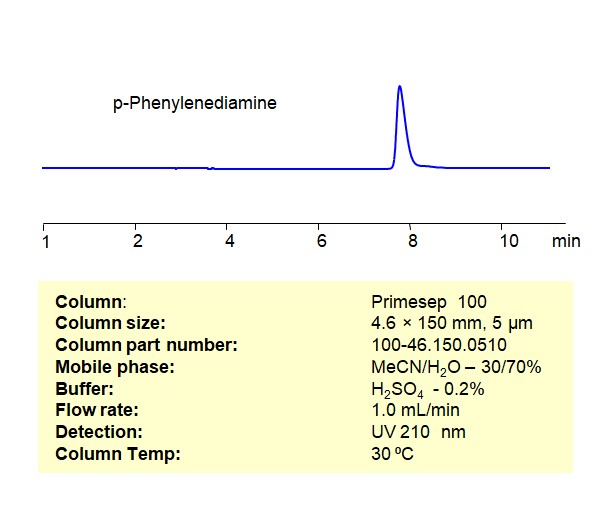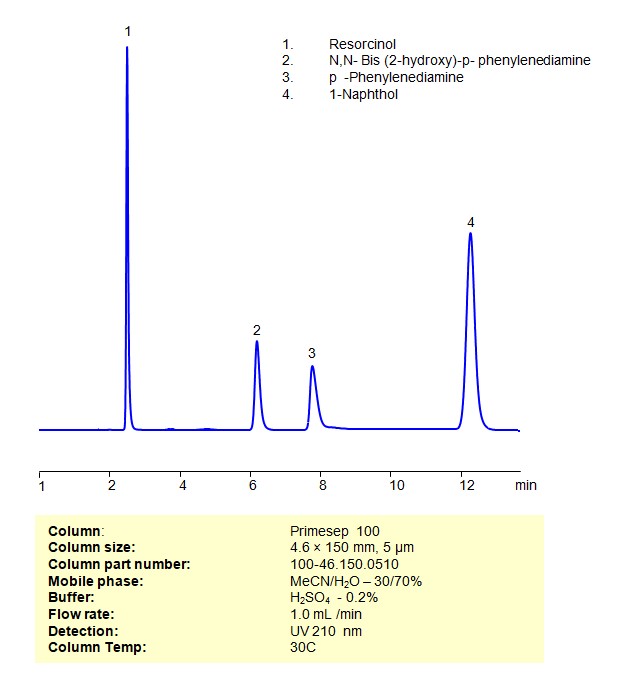
| CAS Number | 108-45-2 |
|---|---|
| Molecular Formula | C6H4(NH2)2 |
| Molecular Weight | 108.14 |
| InChI Key | CBCKQZAAMUWICA-UHFFFAOYSA-N |
| LogP | -0.3 |
| Synonyms |
|
Applications:
UV-Vis Spectrum of m-Phenylenediamine
October 3, 2024
For optimal results in HPLC analysis, it is recommended to measure absorbance at a wavelength that matches the absorption maximum of the compound(s) being analyzed. The UV spectrum shown can assist in selecting an appropriate wavelength for your analysis. Please note that certain mobile phases and buffers may block wavelengths below 230 nm, rendering absorbance measurement at these wavelengths ineffective. If detection below 230 nm is required, it is recommended to use acetonitrile and water as low UV-transparent mobile phases, with phosphoric acid and its salts, sulfuric acid, and TFA as buffers.
For some compounds, the UV-Vis Spectrum is affected by the pH of the mobile phase. The spectra presented here are measured with an acidic mobile phase that has a pH of 3 or lower.

HPLC Method for Analysis of Isomers of Phenylenediamine on Primesep 100 Column
August 1, 2024
High Performance Liquid Chromatography (HPLC) Method for Analysis of o-Phenylenediamine, , m-Phenylenediamine, p-Phenylenediamine on Primesep 100 by SIELC Technologies
Separation type: Liquid Chromatography Mixed-mode SIELC Technologies
High Performance Liquid Chromatography (HPLC) Method for Analysis of o-Phenylenediamine, , m-Phenylenediamine, p-Phenylenediamine
o-Phenylenediamine, m-Phenylenediamine, and p-Phenylenediamine are isomers of phenylenediamine, where the amino groups are attached to different positions on the benzene ring.
These compounds are important in various industrial applications due to their role as intermediates in the synthesis of other chemicals.
o-Phenylenediamine, , m-Phenylenediamine, p-Phenylenediamine can be retained, separated and analyzed using a Primesep 100 mixed-mode stationary phase column. The analysis employs an isocratic method with a simple mobile phase comprising water, acetonitrile (MeCN), and sulfuric acid as a buffer. This method allows for detection using UV 200 nm
| Column | Primesep 100, 4.6 x 150 mm, 5 µm, 100 A, dual ended |
| Mobile Phase | MeCN – 40% |
| Buffer | H2SO4 -0.1% |
| Flow Rate | 1.0 ml/min |
| Detection | UV 200 nm |
| Samples | 0.3 mg/ml in MeCN/H2O – 50/50% |
| Injection volume | 1 µl |
| LOD* | 10 ppb (200 nm) |
| Class of Compounds | Aromatic amines |
| Analyzing Compounds | o-Phenylenediamine, , m-Phenylenediamine, p-Phenylenediamine |
Application Column
Primesep 100
Column Diameter: 4.6 mm
Column Length: 150 mm
Particle Size: 5 µm
Pore Size: 100 A
Column options: dual ended
m-Phenylenediamine
o-Phenylenediamine
p-Phenylenediamine

HPLC Method for Analysis of p-Phenylenediamine on Primesep 100 Column
November 30, 2023
HPLC Method for Analysis of m-Phenylenediamine on Primesep 100 by SIELC Technologies

High Performance Liquid Chromatography (HPLC) Method for Analysis of m-Phenylenediamine
N,N-Bis(2-hydroxyethyl)-p-phenylenediamine (often abbreviated as N,N-Bis(2-hydroxyethyl)-PPD) is a chemical compound that is a derivative of p-phenylenediamine (PPD), a common ingredient in hair dyes.
The N,N-Bis(2-hydroxyethyl)-p-phenylenediamine be retained and analyzed using a Primesep 100 mixed-mode stationary phase column. The analysis employs an isocratic method with a simple mobile phase comprising water, acetonitrile (MeCN), and sulfuric acid as a buffer. This method allows for detection using UV at 210 nm
| Column | Primesep 100, 4.6 x 150 mm, 5 µm, 100 A, dual ended |
| Mobile Phase | MeCN/H2O – 30/70% |
| Buffer | H2SO4 -0.2% |
| Flow Rate | 1.0 ml/min |
| Detection | UV 210 nm |
| Samples | p-Phenylenediamine (1.3 mg/mL) |
| Injection volume | 3 µl |
| Class of Compounds | Aromatic amines |
| Analyzing Compounds | m-Phenylenediamine |
Application Column
Primesep 100
Column Diameter: 4.6 mm
Column Length: 150 mm
Particle Size: 5 µm
Pore Size: 100 A
Column options: dual ended

HPLC Method for Separation of a Mixture of Resorcinol, N,N-Bis (2-hydroxy)-p-phenylenediamine, p-Phenylenediamine and 1-Naphthol on Primesep 100 Column
November 29, 2023
HPLC Method for Analysis of Resorcinol, N,N-Bis (2-hydroxy)-p-phenylenediamine, p-Phenylenediamine and 1-Naphthol on Primesep 100 by SIELC Technologies

High Performance Liquid Chromatography (HPLC) Method for Analysis of Resorcinol, N,N-Bis(2-hydroxy)-p-phenylenediamine, p-Phenylenediamine and 1-Naphthol
Resorcinol – a chemical compound with the formula C6H4(OH)2. It is a dihydroxybenzene used in various applications, including the production of resins and as a topical antiseptic.
N,N-Bis(2-hydroxyethyl)p-phenylenediamine – a compound used in the manufacture of hair dyes and related products.
p-Phenylenediamine – commonly known as PPD, it’s used in hair dyes and black rubber products.
1-Naphthol – a crystalline compound with the formula C10H7OH. It’s used in the synthesis of dyes and perfumes.
All compounds can be retained, separated, and analyzed using a Primesep 100 mixed-mode stationary phase column. The analysis employs an isocratic method with a simple mobile phase comprising water, acetonitrile (MeCN), and sulfuric acid as a buffer. This method allows for detection using UV at 210 nm
| Column | Primesep 100, 4.6 x 150 mm, 5 µm, 100 A, dual ended |
| Mobile Phase | MeCN/H2O – 30/70% |
| Buffer | H2SO4 -0.2% |
| Flow Rate | 1.0 ml/min |
| Detection | UV 210 nm |
| Samples | N,N-Bis(2-hydroxy)-p-phenylenediamine (0.7 mg/mL) p-Phenylenediamine (1.3 mg/mL) 1-Naphthol (0.18 mg/mL) Resorcinol (0.28 mg/mL) |
| Injection volume | 3 µl |
| Class of Compounds | Phenols, Aromatic amines |
| Analyzing Compounds | Resorcinol, 1-Naphthol, N,N-Bis(2-hydroxy)-p-phenylenediamine sulfate, m-Phenylenediamine |
Application Column
Primesep 100
Column Diameter: 4.6 mm
Column Length: 150 mm
Particle Size: 5 µm
Pore Size: 100 A
Column options: dual ended
N,N-Bis(2-hydroxy)-p-phenylenediamine sulfate
Resorcinol
m-Phenylenediamine


